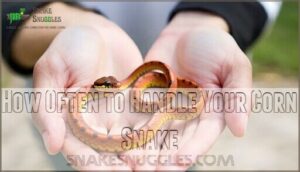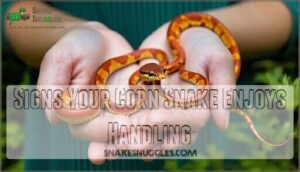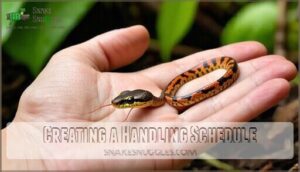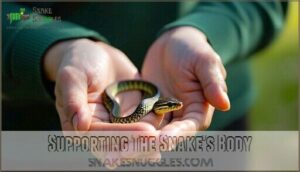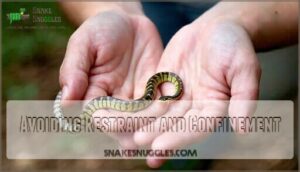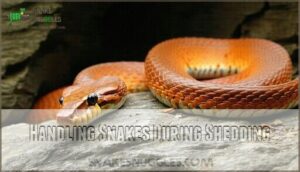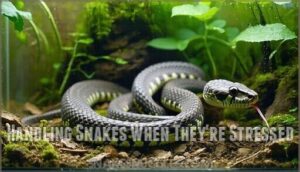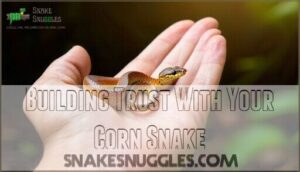This site is supported by our readers. We may earn a commission, at no cost to you, if you purchase through links.
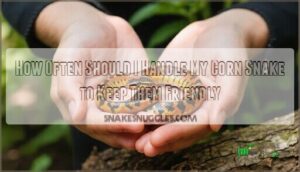
Each session should last 5-10 minutes, giving your snake time to get comfortable without overwhelming them. Start slowly with new snakes, allowing a two-week adjustment period before beginning regular handling.
Watch for relaxed body language like smooth muscle tone and curious tongue flicking—these signs tell you your snake’s enjoying the interaction.
Consistent, gentle handling builds trust over time, transforming even nervous snakes into confident companions. The key lies in reading your snake’s unique personality and adjusting your approach accordingly.
Table Of Contents
- Key Takeaways
- Handling Corn Snakes 101
- How Often to Handle Your Corn Snake
- Signs Your Corn Snake Enjoys Handling
- Signs Your Corn Snake Doesn’t Like Handling
- Creating a Handling Schedule
- Handling Techniques for Corn Snakes
- Common Handling Mistakes to Avoid
- Building Trust With Your Corn Snake
- Monitoring Your Corn Snake’s Stress Levels
- Frequently Asked Questions (FAQs)
- How often should you handle a corn snake?
- Do cornsnakes like to be handled?
- How to tell if a corn snake is happy?
- Do corn snakes like being petted?
- How often should you handle your cornsnake?
- Do corn snakes like to be handled?
- How often do snakes like to be handled?
- Do corn snakes want to be held?
- How long should each handling session last?
- Can I handle my corn snake after feeding?
- Conclusion
Key Takeaways
- Handle adult corn snakes 1-2 times weekly and juveniles 2-3 times weekly – Keep sessions to 5-10 minutes to build trust without overwhelming your snake
- Watch for relaxed body language, like smooth muscle tone and curious tongue flicking – These signs tell you your snake is comfortable and enjoying the interaction
- Always wait 48 hours after feeding before handling – This prevents dangerous regurgitation and reduces stress on your snake’s digestive system
- Stop handling immediately if you see stress signals, like hissing, musking, or defensive posturing – Respect your snake’s boundaries to maintain the trust you’ve built over time
Handling Corn Snakes 101
Handling your corn snake properly helps maintain their friendly temperament and builds trust between you and your pet.
Learning the correct techniques and frequency guarantees your snake remains calm and comfortable during interactions.
Why Handling is Important for Corn Snakes
Handling corn snakes offers three essential benefits for their wellbeing.
Regular handling helps you monitor their health, build trust through bonding benefits, and provides necessary enrichment.
Consistent, gentle handling transforms nervous snakes into confident, trusting companions through positive bonding experiences
Here’s why corn snake handling matters:
- Health monitoring – You’ll spot weight changes, injuries, or illness early
- Temperament impact – Consistent handling keeps your snake calm and friendly
- Exercise needs – Movement outside their enclosure promotes physical fitness
To guarantee a positive interaction, remember to allow for a two-week acclimation period when introducing a new corn snake to its home.
How to Handle Corn Snakes Safely
Safe corn snake handling starts with proper support using both hands—one near the head, another mid-body. Approach from the side with gentle movements to avoid triggering defensive responses.
Maintain hand hygiene by washing before and after contact. Create a calm environment with adequate lighting. Support the snake’s entire body while allowing natural movement.
Utilizing a snake handling tool can also aid in safely interacting with your corn snake. These snake handling precautions prevent injuries and build trust through consistent, respectful safe snake handling practices.
Tips for First-Time Corn Snake Owners
As a beginner, you’ll want to establish the right corn snake handling frequency from day one.
Start with brief 5-10 minute sessions once your snake settles into their new enclosure setup. Move slowly and support their body completely—this builds trust and maintains your friendly corn snake’s calm temperament.
Wait until they’re eating regularly before beginning handling corn snakes, as proper feeding schedule adherence reduces stress during these vital bonding moments.
How Often to Handle Your Corn Snake
Determining the right handling frequency keeps your corn snake comfortable and maintains their friendly disposition.
Several factors influence how often you should handle your snake, including their age, temperament, and current health status.
Factors Affecting Handling Frequency
Several key factors determine your corn snake handling frequency.
Your snake’s unique temperament and environment shape how often they’ll enjoy your company
Your snake’s unique needs depend on three main elements:
- Individual temperament – Docile personalities tolerate up to five weekly sessions, while skittish snakes need once-weekly handling
- Health and shedding cycle – Avoid handling during blue phase or within 48 hours after recent meals
- Environmental stability – Consistent routines reduce snake stress and improve handling tolerance
Age influences metabolism and stress response during interactions.
Consistent, gentle handling can improve a snake’s temperament, and help build trust through interaction.
Handling Frequency for Juvenile Corn Snakes
Young corn snakes need consistent but gentle handling to build trust while avoiding juvenile stress.
Start with brief interactions of 5-10 minutes, handling 2-3 times weekly after initial acclimation. This regular handling frequency supports proper corn snake temperament development.
Gradual increase in session length helps baby snakes adjust to human contact. Consistent handling baby snake routines promote faster acclimation speed without overwhelming them.
Age Group Handling Frequency Handling Tips
Handling Frequency for Adult Corn Snakes
Adult corn snakes thrive with handling frequency of once weekly, though some tolerate twice-weekly sessions.
Your corn snake temperament affects this schedule – calmer snakes may enjoy more interaction while shy ones prefer less.
Watch for overhandling signs like defensive posturing or musking.
Seasonal impact matters too, as snakes become less active during cooler months, requiring reduced handling duration and frequency.
Signs Your Corn Snake Enjoys Handling
Understanding your corn snake’s body language helps you recognize when they’re comfortable with handling and maintain their friendly temperament.
A relaxed snake will move slowly and smoothly in your hands, showing curiosity rather than fear or aggression, and this behavior indicates they are comfortable with their environment.
Body Language Indicators
How can you tell if your corn snake feels comfortable during handling?
Your snake’s body language reveals important clues about their emotional state and comfort level.
- Relaxed tongue flicking: Frequent, steady tongue movements show curiosity rather than defensive postures
- Smooth muscle tone: Minimal tension in the body indicates relaxation signals and acceptance of interaction
- Calm breathing patterns: Steady, unhurried respiration without rapid hissing demonstrates comfort
- Lack of musking behavior: Absence of defensive scent release suggests your snake body language reflects trust
Behavioral Signs of Enjoyment
Watch for these behavioral signs that indicate your corn snake enjoys handling. Exploratory behavior shows genuine engagement – your snake actively moves around your hands and arms instead of freezing up.
You’ll notice voluntary approach behavior when your snake comes toward you during cage maintenance rather than hiding. This suggests a positive association with your presence. Extended time outside their hide after handling sessions reflects comfort and successful corn snake bonding.
A flattened body, however, can indicate a defensive body posture.
- Active exploration: Your snake curiously investigates your hands, showing relaxed posture and slow movements
- Voluntary climbing: They willingly climb onto your arm or shoulder without coaxing
- Calm tongue flicking: Steady, unhurried tongue flicking indicates curiosity shown rather than defensive behavior
Physical Signs of Relaxation
Beyond watching how your corn snake behaves, you can spot relaxation through clear physical signs.
When your snake feels secure during corn snake handling, you’ll notice distinct changes in their body language and movements.
Physical indicators of a comfortable snake include:
- Muscle relaxation: Your snake’s body feels loose and flexible rather than tense or rigid when you support them
- Slow movement patterns: Calm breathing and gentle, unhurried movements show your snake isn’t stressed or anxious
- Gentle tongue flicking: Relaxed snakes exhibit slow, curious tongue flicking instead of rapid, defensive sampling of their environment
Body straightening during handling also signals comfort, as stressed snakes typically coil tightly.
These signs of comfort in snake behavior help you recognize when your corn snake enjoys interaction and feels safe in your hands.
Signs Your Corn Snake Doesn’t Like Handling
Understanding when your corn snake doesn’t enjoy handling helps you maintain a positive relationship with your pet.
Recognizing these warning signs allows you to adjust your approach and keep your snake comfortable during interactions.
Behavioral Signs of Stress
When your corn snake feels overwhelmed, their behavioral responses send clear messages about their stress levels.
Recognizing these corn snake stress signals helps you adjust your snake handling frequency appropriately.
Here are key behavioral signs of distress to watch for:
- Hissing sounds – Your snake produces sharp, audible warnings when feeling threatened
- Erratic movements – Frantic escape attempts and rapid, uncontrolled motions indicate high anxiety
- Musking defense – Releasing foul-smelling secretions signals extreme discomfort during handling
- Refusal feeding – Stress often leads to appetite loss after handling sessions
These snake defensive mechanisms indicate your pet needs space to decompress.
To reduce stress, providing essential hiding spots within the enclosure is vital.
Physical Signs of Discomfort
Physical discomfort manifests through your snake’s body language in unmistakable ways.
When stressed, your corn snake’s breathing becomes rapid and labored, signaling distress.
Watch for these physical warning signs:
- Defensive posture – body flattened or coiled tightly
- Erratic movements – frantic escape attempts or rigid muscles
- Musking odor – releasing foul scent when uncomfortable
Creating a Handling Schedule
Establishing a consistent handling routine helps your corn snake become more comfortable with human interaction and maintains their friendly temperament.
You’ll need to take into account your snake’s age, individual personality, and current stress levels when creating a schedule that works for both of you, considering complete concepts.
Setting a Routine for Handling
Establishing a consistent schedule helps your snake predict and feel comfortable with handling sessions.
Start with short sessions once weekly, then use gradual introduction to increase frequency based on your snake’s response.
Observe behavior closely during each interaction – relaxed movement and calm demeanor indicate success.
This positive reinforcement approach builds trust while maintaining proper handling frequency for corn snake handling tips.
Adjusting Handling Frequency Based on Age
Your snake’s age directly impacts handling corn snakes frequency and duration. Baby Snake Handling requires gentle 5-minute sessions twice weekly to prevent Age-Related Stress.
Juvenile Handling Needs increase gradually as they adapt to snake socialization.
- Babies: 5 minutes, twice weekly with extra care
- Juveniles: 10 minutes, three times weekly for corn snake taming
- Adults: 15-20 minutes, 2-3 times weekly for ideal snake handling
- Seniors: Brief Senior Snake Care sessions once or twice weekly
Adult Handling Differences reflect their increased size and confidence, while corn snake handling frequency should always match your pet’s individual comfort level.
Considering Your Snake’s Individual Needs
Every corn snake has its own temperament variations and unique personality that affects snake handling frequency recommendations.
Consider your snake’s age differences, health status, seasonal behavior, and handling history to create the perfect schedule.
Some snakes enjoy frequent interaction while others prefer minimal contact.
Monitor your pet’s response to determine ideal snake handling and stress reduction strategies.
Understanding snake temperament and recognizing snake nervousness helps you customize handling during the snake handling and acclimation period.
Handling Techniques for Corn Snakes
Proper handling technique keeps your corn snake comfortable and prevents injuries during your interactions together.
You’ll need to support their body correctly, avoid restraining movements, and use extra care when they’re preparing to shed their skin, which involves proper handling and extra care.
Supporting The Snake’s Body
Supporting your corn snake’s body properly creates the foundation for safe, stress-free handling.
Use both hands for mid-body support, avoiding dangling that can injure their spine.
Hand placement should distribute weight evenly with a secure grip.
Practice body awareness by supporting multiple sections simultaneously.
A useful tool for handling can be a snake hook.
These handling techniques reduce anxiety and guarantee your snake feels secure throughout each handling duration, following proper snake handling guidelines for superior snake handling support without tail support.
Avoiding Restraint and Confinement
Nobody wants to wrestle with their corn snake during handling sessions. Your snake needs gentle support and body freedom to feel secure and explore naturally. Use a loose grip that allows natural movement while providing safety. Think of yourself as a living tree branch rather than a restraining device.
Corn snake handling works best when you follow these snake handling best practices:
- Support multiple points along the snake’s body without squeezing
- Allow your snake to flow between your hands during safe exploration
- Keep movements slow and predictable to maintain trust
- Let the snake choose its path while you guide gently
These snake handling techniques create positive experiences that strengthen your bond over time.
Gentle Handling for Shedding Snakes
During corn snake shedding cycles, reduce handling frequency to minimize skin irritation.
When necessary, use a gentle approach with slow, deliberate movements and full body support.
Increase enclosure humidity before any interaction to soften loose skin.
Watch for shedding signs like cloudy eyes and avoid handling risks by keeping sessions brief.
Return your snake promptly if defensive behaviors appear, and remember to always handle them with care to prevent skin irritation.
Common Handling Mistakes to Avoid
Even experienced snake owners make mistakes that can stress their corn snake or damage the trust you’ve built together.
Understanding these common errors helps you avoid setbacks and keeps your snake comfortable with regular handling.
Handling Snakes During Shedding
Never handle your corn snake during shedding time – it’s experiencing Shedding Stress and vulnerability. Watch for the Blue Phase when eyes turn cloudy and skin dulls. Handling Risks increase substantially during this period.
Safe Alternatives during snake shedding:
- Provide adequate humidity for Shedding Aid
- Offer rough surfaces for skin removal
- Monitor from distance only
- Maintain consistent temperatures
- Wait until shed completes entirely
Reptile shedding requires patience – your corn snake shedding process demands respect for their natural cycle. Snakes may also exhibit defensive behavior during this sensitive time.
Handling Snakes After Feeding
Your corn snake needs time to digest after meals. Handling after feeding creates regurgitation risk and stress. Wait 48 hours before any snake handling activity.
Food size affects digestion timeline – larger meals require longer handling delays. Your corn snake’s activity levels indicate readiness for interaction.
| Timeline | Food Size | Handling Safety |
|---|---|---|
| 24 hours | Small prey | Still digesting |
| 48 hours | Medium prey | Safe to handle |
| 72 hours | Large prey | Fully processed |
| 96 hours | Oversized meal | Complete digestion |
| 1 week | Refused food | Monitor closely |
Handling Snakes When They’re Stressed
Stressed snakes need space, not handling—it’s like forcing conversation on someone having their worst day.
When you notice defensive behaviors, respect your snake’s boundaries and postpone interactions until they’ve calmed down.
- Hissing or striking behavior signals immediate stress
- Tight coiling indicates your snake feels threatened
- Rapid tongue flicking shows heightened anxiety levels
- Refusing food suggests ongoing stress or illness
- Excessive hiding means they need quiet recovery time
Building Trust With Your Corn Snake
You can build trust with your corn snake by starting with short, gentle handling sessions and gradually increasing the time as it becomes comfortable.
Consistent, calm interactions help your snake recognize you as a safe presence, making future handling easier and less stressful.
Starting With Short Handling Sessions
Building trust starts with keeping your initial duration short.
Begin with 5-minute sessions to help your corn snake adjust without overstimulation.
These brief encounters allow juvenile acclimation while building confidence.
Short snake handling duration prevents stress and creates positive reinforcement.
Your snake learns that corn snake handling means safety, not danger.
These corn snake handling for beginners sessions establish the foundation for future trust-building interactions.
Gradually Increasing Handling Time
After your snake feels comfortable with brief encounters, you can slowly extend session length.
This gradual progression builds trust and strengthens your bond. Watch your snake’s comfort levels closely during this process.
- Increase handling milestones by 30-60 seconds weekly
- Monitor corn snake behavior for stress signals
- Respect individual snake handling duration limits
- Practice patience required for proper snake acclimation
Rewarding Calm Behavior
After your snake grows comfortable with extended sessions, you can reinforce calm behavior through positive reinforcement techniques.
Gentle handling paired with immediate rewards like returning to a warm hide helps build confidence.
Some handlers use clicker training to mark desired behaviors, though food rewards work less effectively with corn snakes than environmental enrichment during handling corn snakes sessions.
Monitoring Your Corn Snake’s Stress Levels
Your snake’s stress levels directly impact how often you can handle them without causing harm.
Watching for stress signals like hissing, rapid movement, or defensive posturing helps you adjust your handling routine to keep your corn snake comfortable and friendly.
Recognizing Signs of Stress
Consistently monitoring your corn snake’s behavior helps you spot stress before it becomes problematic.
Stressed snakes communicate through clear physical and behavioral changes that signal when handling should stop.
Watch for these key stress indicators:
- Hissing Behavior and defensive postures when you approach their enclosure
- Musking Response or erratic movements during handling sessions
- Refusal to Eat combined with increased hiding and withdrawal from interaction
Adjusting Handling Frequency and Technique
When you spot stress signals, quick adjustments prevent lasting damage to your snake’s temperament.
Reduce handling frequency during seasonal handling periods or brumation effects.
Shorten corn snake handling duration if your pet shows defensive behaviors.
Modify handling techniques based on temperament changes – some snakes need gentler approaches after illness or injury handling.
Snake handling frequency should decrease when stress appears, giving your corn snake time to recover before resuming normal interaction schedules, allowing for a more gentle approach to prevent lasting damage.
Providing a Stress-Free Environment
After adjusting your corn snake handling approach, create a quiet handling space with proper enclosure setup that promotes snake wellbeing.
Maintain consistent temperatures, provide multiple hideouts, and follow gradual acclimation principles.
To guarantee appropriate environmental conditions, consider investing in a reptile habitat monitor.
Recognizing stress signs helps prevent overhandling while these handling techniques and snake handling tips support your pet’s comfort.
Monitor snake stress indicators regularly for superior results.
Frequently Asked Questions (FAQs)
How often should you handle a corn snake?
While daily interaction builds trust, weekly handling sessions of 10-15 minutes work best.
You’ll maintain your snake’s friendliness without causing stress, letting them rest between encounters while staying comfortable with human contact, which is crucial for daily interaction and weekly handling.
Do cornsnakes like to be handled?
Corn snakes don’t particularly enjoy handling like some pets do, but they’ll tolerate it well when properly acclimated.
They’re naturally docile creatures that adapt to gentle, consistent interaction without significant stress, and are docile by nature.
How to tell if a corn snake is happy?
You’ll know your snake’s content when it explores calmly, maintains healthy eating habits, shows relaxed body language, and doesn’t exhibit stress behaviors like excessive hiding or defensive posturing.
Do corn snakes like being petted?
Corn snakes don’t enjoy petting like cats or dogs.
They tolerate gentle touching but prefer minimal contact.
You’ll want to avoid stroking them frequently since they’re more comfortable with brief, supportive handling sessions.
How often should you handle your cornsnake?
Handle your corn snake once or twice weekly for 10-15 minutes each session.
This frequency maintains their docile nature without causing stress, while allowing proper time between feedings and molting periods.
Do corn snakes like to be handled?
Like a cautious cat meeting a new friend, corn snakes don’t naturally crave human contact but can learn to tolerate handling well.
They’re not affectionate pets but become comfortable with gentle, consistent interaction once properly acclimated.
How often do snakes like to be handled?
Most snakes prefer minimal handling—once or twice weekly for 10-15 minutes works well.
You’ll want to watch their body language and respect when they’re not in the mood for interaction, which can be considered a complete concept of understanding snake behavior.
Do corn snakes want to be held?
Picture a cat that tolerates petting but doesn’t purr with joy—that’s your corn snake’s relationship with handling.
They don’t crave contact like dogs, but they’ll accept gentle interaction when you’re patient and respectful.
How long should each handling session last?
Start with 5-minute sessions for new corn snakes, then gradually increase to 10-15 minutes as they become comfortable. You’ll want to keep sessions brief to prevent stress while building trust.
Can I handle my corn snake after feeding?
No, don’t handle your corn snake within 48 hours after feeding. This waiting period prevents regurgitation, which can be dangerous for your snake’s health and stress levels.
Conclusion
Mastering how often should i handle my corn snake to keep them friendly transforms you into an absolutely incredible snake whisperer.
Regular handling sessions create lasting bonds with your reptilian companion. Adult corn snakes thrive with 1-2 weekly interactions, while juveniles benefit from 2-3 sessions per week.
Remember that consistency matters more than frequency. Watch your snake’s body language and adjust accordingly. Some snakes prefer more interaction, others need less.
Building trust takes patience, but the rewards include a confident, relaxed pet that enjoys your company for years to come.
- https://www.youtube.com/c/LoriTorriniAnimalBehavior
- https://www.reptifiles.com/corn-snake-care-guide/corn-snake-diseases-health/corn-snake-shedding/
- https://reptifiles.com/corn-snake-care-guide/corn-snake-handling-body-language/
- https://www.quora.com/How-long-does-it-take-for-a-corn-snake-to-get-used-to-being-handled
- https://www.reddit.com/r/cornsnakes/comments/xd8pwf/what_is_the_best_way_to_tell_of_a_corn_snake_is/

